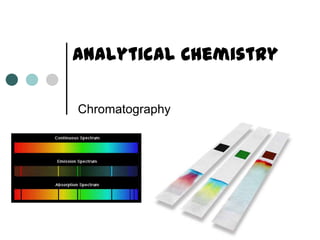
Analytical chemistry
- 2. Chromatography A technique for separating and identifying components in a mixture. Components have different affinities for two phases: a stationary phase and a mobile phase A component which has a strong attraction for the mobile phase will move quickly, while a component with a strong attraction for the stationary phase will be held back.
- 3. Main types of chromatography Paper chromatography Thin layer chromatography (TLC) Column chromatography Gas-liquid chromatography (GLC) Gas chromatography – mass spectrometry (GCMS) High Performance Liquid Chromatography (HPLC)
- 4. Paper chromatography Paper composed mostly of cellulose. Polar due to hydroxyl groups “Dry” paper is actually ~10% water (H-bonded to –OH) groups Polar water bonded to paper = stationary phase Added solvent (eluent) = mobile phase
- 5. Paper chromatography Small amt. mixture spotted onto paper Starting point marked Paper suspended in small quantity of solvent (eluent) Closed container (prevents solvent evaporation & speeds process) As solvent rises, components partition between two phases bases on relative solubility. Solvent front is marked at end of separation Colored components can be seen/measured Other components may be made visible with stain (i.e. iodine or ninhydrin) or UV light
- 6. Paper chromatography Each solute will have a constant retention factor (Rf) for a given eluent. If two substances have similar Rf values in one solvent, the paper can be turned 90 and eluted with a different solvent for further separation. Known as two-way chromatography Often used to separate amino acids
- 7. Paper chromatography Calculating solute retention factors: Rf distance moved by solute distance moved by solvent (eluent) R f(red) R f(blue) 7.5 cm 10.0 cm 2.5 cm 10.0 cm 0 . 75 0 . 25
- 8. Paper chromatography You try it… (caluclate the Rf values) R f(cyan) R f(magenta) R f(yellow) 4.2 cm 4.5 cm 3.2 cm 4.5 cm 1.8 cm 4.5 cm 0 . 93 0 . 71 0 . 40
- 9. Thin layer chromatography (TLC) Similar to paper chromatography Thin layer of a solid is painted onto an inert support, such as glass Common solids: • Alumina (Al2O3) • Silica (SiO2)
- 10. Thin layer chromatography (TLC) When absolutely dry works by adsorption However, like paper, silica and alumina are very hygroscopic (water-loving) and therefore separation occurs more by partition, with water as the stationary phase. Separated components can be recovered by scraping off the section containing the component and dissolving it in a suitable solvent.
- 11. Thin layer chromatography (TLC) Pregnancy tests may use TLC to detect pregnanediol in urine.
- 12. Thin layer chromatography (TLC) Advantages of TLC over paper chromatography: Approx. three times faster More efficient – small samples can be separated and components can easily be recovered in pure form Results are more easily reproduced Range of mixtures can be separated by changing mobile and stationary phases
- 13. Column chromatography Essentially large-scale TLC Usually used to separate mixture components for further use rather than simple ID. Stationary phase often alumina or silical gel (SiO2 xH2O)
- 14. Column chromatography Mixture dissolved in minimum volume of solvent Added to top of column Sample is eluted (fresh solvent added to the top to wash sample down the stationary phase) Components separated as they travel at different rates – collected at bottom as different fractions. Solvent can also be changed to elute more tightly held components.
- 15. Gas-liquid chromatography (GLC) Used to separate and ID gases and volatile liquids
- 16. Gas-liquid chromatography (GLC) Sample injected into oven where it is vaporized Vapor carried by inert gas (mobile phase) over a non-volatile liquid (stationary phase). N2 and He are typical carrier gases Long-chain alkanes w/ high b.p.’s supported on a SiO2 (glass) surface typically act as stationary phase
- 17. Gas-liquid chromatography (GLC) Components generally exit to a flame ionization detector connected to a chart recorder. The less volatile (lower b.p.) the component, the greater the retention time.
- 18. Gas-liquid chromatography (GLC) Used to identify components that can vaporize without decomposition Examples: Illegal steroids and stimulants in urine Blood-alcohol levels Underground mine gases
- 19. Gas chromatography – mass spectrometry (GCMS) Like GLC, but employs mass spectrometry instead of flame ionization detector at exit point.
- 20. Gas chromatography – mass spectrometry (GCMS) Computer matches the spectra and gives a printout of all components and their concentrations. Very powerful tool and used extensively in forensic science, medicine, etc. Mass spectrometer is connected to a computer which contains a library of the spectra of all known compounds.
- 21. High Performance Liquid Chromatography (HPLC) Like LC (column chromatography) but employs pressure instead of just gravity to force mobile phase through column. Stationary phase is typically silica with long-chain alkanes adsorbed to surface, Efficient separation, so long columns not needed. Remember your liquid chromatography lab with grape KoolAid? sep-pak C18 cartridge
- 22. High Performance Liquid Chromatography (HPLC) Separated components often detected via IR spectroscopy. Like GLC, results recorded onto chart showing different retention times.
- 23. High Performance Liquid Chromatography (HPLC) • Can be used for ID as well as for separation Can also be used to separate enantiomers (chiral separation) using columns containing optically active material. Other uses include analysis of oil pollutants, alcoholic beverages, food (antioxidants, sugars and vitamins), pharmaceuticals, polyme rs, quality control of insecticides
